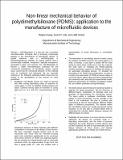| dc.description.abstract | Soft-lithography is a low-cost and convenient microfabrication technique that is becoming increasingly popular in the manufacture of microfluidic devices. A typical elastomer used in soft-lithography is polydimethylsiloxane (PDMS), an organic polymer that is commercially available, inexpensive, optically transparent, permeable to gases, and nontoxic. For soft-lithography to become a viable microfabrication technique for the commercial manufacture of microfluidic devices, several issues concerning the mechanical behavior of this material must be considered and addressed. We are currently working on the following materials-related issues that are critical to the development of this process for mass production:
<br/>•Multilayer microfluidic devices are made by layering thin films having alternating ratios of monomer to curing agent, in order to facilitate bonding between the layers. Common mixing ratios of monomer to curing agent are 5:1, 10:1, and 20:1. Characterization of the mechanical behavior of these materials with different compositions is necessary in the design of these devices. We have conducted uniaxial tension tests at the macroscale and found that the monomer-to-curing agent ratio contributes significantly to the non-linear stress-strain behavior of PDMS (see adjoining figure). We are working on uniaxial tension tests on microscale specimens which are approximately 10 µm thick and have a gauge width of 1 mm; this smaller scale is representative of actual dimensions in microfluidic devices.
<br/>•The fabrication of microfluidic devices involves curing the mixture of PDMS monomer and curing agent on a mold. Currently, a cast layer is peeled off the mold slowly by hand, being careful not to tear the material. We shall work on modeling the PDMS-substrate interface decohesion response to facilitate the design of an automated demolding process. To simulate the demolding of the PDMS during fabrication, we plan to conduct peel experiments of PDMS at various stages of cure from silicon, plastic, glass and other substrates that are commonly used; and using the experimental results, determine parameters for interface constitutive models for use in failure prediction during demolding.
<br/>•We shall conduct experimental and numerical studies to optimize the design parameters, like the thickness of different layers, composition of materials used, and geometry of microchannels for microfluidic devices. The layers within a multilayer microfluidic device appear to bond irreversibly, but the strength of the bond is not understood. We plan to conduct peel experiments to test the bond between different PDMS layers of different compositions. The channels within the microfluidic devices are usually pressurized during actuation, so we also plan to conduct blister tests to understand the interface failure behavior between the different layers of a device.
<br/>•Reliability of these devices is an issue that has not been addressed. All devices are currently made in a laboratory environment, and the limits of pressure magnitude and cyclic frequency of these devices have not been explored. We plan to experimentally study the fatigue behavior of these devices, and develop appropriate guidelines for reliable use of these devices. | en |
